Traveling Through Corporate Time: Inevitability and (Anti-) Corporate Narrative Form
by Adam Haley
Published December 2015
Over the last half-century, as large for-profit corporations have increasingly come to set the terms for quotidian life in the present, so have they loomed large in pop-cultural imaginings of the future, particularly those with a dystopian bent. From the Soylent Corporation and Dune’s CHOAM to Tyrell Corp (Blade Runner), Weyland-Yutani (the Alien franchise), and Cyberdyne Systems (the Terminator franchise), the profit-seeking behaviors of particular fictional corporations have repeatedly metastasized into this or that totalizingly oppressive state of affairs. Iterated to the point of cultural saturation, the trope of the evil (or at least out-of-control) corporation in speculative genres marks future-fictional corporations as objects of suspicion regardless of their particular products, services, or behaviors, such that even generically-named corporate entities like Resident Evil’s Umbrella Corporation or District 9’s Multinational United (whose names denote only their scale and reach) are immediately legible as dystopian antagonists. Rather than harboring some latent dystopian potential, these corporations seem immediately to carry with them an essentially dystopian quality, eliciting suspicion not just of whatever particular chain of events they might eventually actuate but of the dystopian character of the corporation as such. Under the weight of such depictions, the corporation itself has gradually become a primary object of dystopian fear, arguably surpassing even its twin antagonist and occasional co-villain, the authoritarian state.
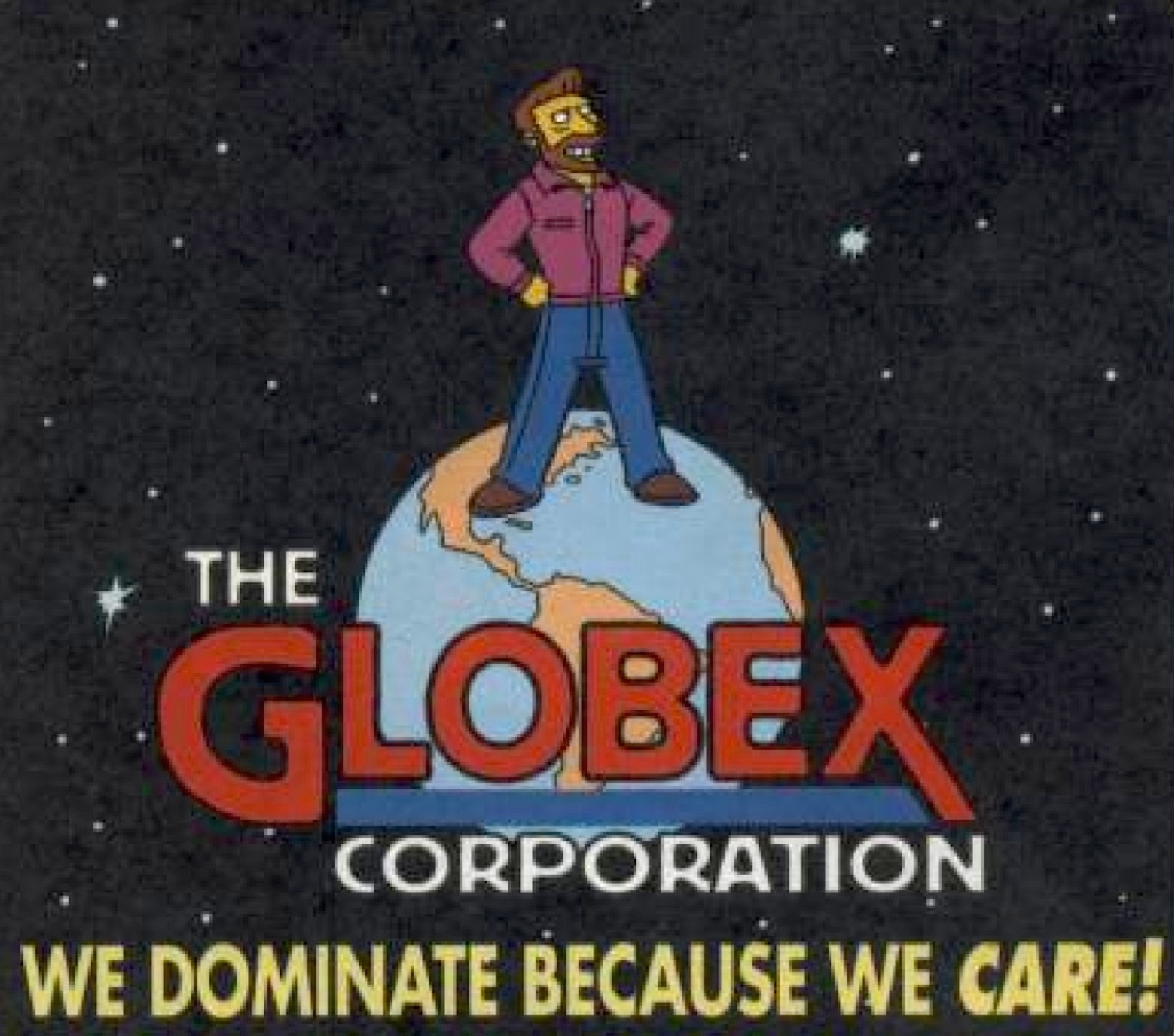
This representational transition—from the corporation as merely a vehicle of or scapegoat for dystopian scenarios to the corporation as intrinsically dystopian—certainly has its real-world antecedents and contexts. It coincides with a broader suspicion of corporate capitalism in the wake of anti-globalization and anti-consumerist protest movements, and it also resonates with a post-Cold War shift in the forms of collectivity feared by (often staunchly individualist, especially in U.S. contexts) culture producers, from the totalizing state to the totalizing multinational. But above and beyond tracing the connections between fictional corporate dystopias and broader antipathies toward real-world corporate hegemony, my driving question here is what the corporation’s prominence in the landscape of contemporary anxieties about the future suggests about the shape of our future-thinking. Animating this inquiry is a desire to understand the corporation not just as a real-world phenomenon occasionally represented or reflected in fiction, but rather as itself a narrative, cultural, and discursive entity with profound ideological effects. A guiding principle, then: the contours of the corporation in fiction are neither incidental to nor separable from the corporation’s real-world functioning, a key feature of which is how the corporation reprograms our thinking about the future.
Though the for-profit corporation’s apparent affinity with futurity (and thus its prominence in science-fictional futures) may stem partly from the future-orientation of capitalism’s perpetual growth imperatives and of finance’s monetization of the speculative, I argue that a more deep-seated form of corporate futurity inheres in the algorithmic, self-propagating structures of the corporation itself. Defined in William Blackstone’s 1765 Commentaries on the Laws of England as “many persons united together into one society . . . kept up by a perpetual succession of members, so as to continue for ever” (457), the corporation, even in its early mercantile and colonial iterations, was engineered specifically to transcend its particulars in perpetuity, to secure its ongoing legal and commercial functioning beyond the loss of any of its constituent parts (human or nonhuman). Though the doctrine of perpetual succession encodes this futurity in contract law, this codified perpetuity is on some level as much imaginative act as procedural design, a narrative analog to the future-recursive processes by which the corporation is defined and propelled.
Following Henry Turner’s sense that the corporation depends as much on discursive, rhetorical, and narrative elements as on its legal, political, or economic functions (125-127), we might thus say that one vital aim of the corporation as an apparatus is to narrate itself into inevitability, to inscribe itself as a preordained and unshakeable feature of any and all imagined futures. Whatever the actual fate of any given corporate enterprise, this sense that the corporation will always inevitably continue is precisely the rhetorical foundation upon which the corporate venture rests, the ironclad story it must tell itself and its members and investors before setting out into the world. Even if many corporations hemorrhage money or fail altogether, the production of a sense of inevitability is a key component of the rhetorical and narrative software by which the corporation establishes and maintains hegemony. Contemporary corporations have become phenomenally adept at this task, putting a face (or a brand) to Fredric Jameson’s oft-cited dictum that it is now “easier to imagine the end of the world than to imagine the end of capitalism” (76); post-Apple living or a world without Walmart register as speculative-fictional departures in and of themselves. This systematic production of inevitability also suggests the corporation’s kinship with the dystopian imaginary, insofar as dystopia’s most fundamental essence is the systematization of inevitability in the shape of inescapable totalitarian oppression, regardless of a given dystopia’s particular mechanics of immiseration and dehumanization.
Through this network of associations, in particular its mediation between narratives about corporations and the corporation as itself a kind of narrative machine, the cultural specter of the corporation usefully indexes the shape of inevitability in a broad swath of contemporary thoughts and fears about the future. Insofar as futurity continues to take on increasing significance as an object of rhetorical struggle, economic investment, and political imagination, its ongoing restructuring by corporate entities assumes great urgency. But the corporation’s influence on the structures of future-thinking goes beyond real-world corporate ownership of cultural production and distribution venues; it has to do, rather, with the corporation’s own narrative machinery, the ramifications that that machinery has outside of the corporate assemblage, and the way that machinery interfaces across legal, political, economic, and cultural registers. In this light, I propose, the corporation writ large might function most saliently not as one component of this or that seemingly inevitable future, but as part of the very structure of inevitability as such, the vector along which the future comes increasingly to seem predetermined, its particular fixtures unavoidable and thus not worth debating or resisting. Thus, the contemporary dystopian fear par excellence: not just that the corporation is inevitable, but that inevitability might be somehow ineluctably corporate.
• • •
In terms of narrative typology, the modern corporation as it is most commonly imagined by activists and novelists alike—joint-stock, limited-liability, multinational—might well be political economy’s most science-fictional trope. Its body is virtualized, a global agglomeration of disparate interests (both stake- and stockholders) into what might once have been merely another form of collective representation but in postindustrial life seems to rise to the level of networked posthuman embodiment. One thinks of William Gibson’s evolutionary description of Blue Ant, the postmodern marketing firm at the heart of Pattern Recognition (2003): “Relatively tiny in terms of permanent staff, globally distributed, more post-geographic than multinational . . . a high-speed, low-drag life-form in an advertising ecology of lumbering herbivores. Or perhaps . . . some non-carbon-based life-form” (6). This advanced life-form, exceptional in the novel’s marketing landscape but emblematic of the kind of posthuman corporate person at the heart of so many post-Citizens United fears and fantasies, feeds on both financial and imaginative speculation. At Blue Ant’s heart churns an avowedly futural engine, running on the corporation’s own implausible but no less propulsive fantasies of indefinite survival, inexhaustible accumulation, and infinite speed.
Following Gibson’s diagnosis of the corporate cutting-edge (a fantasy authored and propagated as much by the corporate world and its boosters as by science fiction writers), despite the contemporary corporation’s profound reshaping of the present, it can be said to rely on not being itself present. Just as its incorporated body is a kind of virtualized posthuman aggregation, exceeding any of its constituent bodies and any material headquarters in which they might congregate, so does its temporal structure necessarily outstrip the present moment, diffused through and between possible futures in perpetual succession. The corporation is always what it will be, what it will be worth—every earnings report a speculative fiction, every assertion of value a pointer to some future value, indefinitely deferred. Turner describes the corporation as “a machine for reconciling differing systems of value by means of narration” (133), and I argue that this constitutive narrative mediation requires, in particular, a kind of cross-temporal fluency, a facility with moving across a set of possible, not necessarily compatible futures between which value is constellated.
Even more specifically than the Gibsonian affinity between the corporate and the science-fictional, that is, I argue that the trope of time travel is an essential component of the corporation’s narrative machinery. To be clear, I am not suggesting time travel as a metaphor or figure for how the corporation operates, but rather as a vital part of its narrative interface, of its “durable assemblage of human persons and nonhuman things; of technologies, economic practices, and information-gathering procedures” (Turner 127). To grapple with the cultural specter of the corporation at the nexus of fictional imagining and real-world operation, with the way it has permeated future-thinking in general and the dystopian imaginary in particular, is to think through the corporation’s narrative dependence on a kind of time travel between the futures it capitalizes and the present in which it operates.
• • •
Enter 2012’s Continuum, perhaps 21st century television’s most earnest attempt to grapple with the role of the large for-profit corporation in our collective future. The series opens in 2076 Vancouver, in a slickly corporate milieu whose polished skyscrapers, Minority Report-styled interfaces, and gleaming golden-hour skyline appear too unblemished not to imply off-screen disparities of wealth and power (particularly in the wake of the 2007-2008 financial crisis and the resulting attention to spiraling inequality). A well-dressed man, seated at an executive desk in a well-appointed office, pauses before opening an audiovisual broadcast and speaking to an unseen audience:
Twenty years ago, when the corporations bailed out our failed governments, they sold it to us as salvation. Now, we see that we have paid for that rescue with our freedoms. We have awakened to the truth: we have become slaves to the Corporate Congress. Today, all that changes. Let the word go forth from this time and place, to friend and foe alike, that we have passed the torch to a new generation unwilling to permit the undoing of human rights and dignities. And let every corporation know, whether it wishes us well or ill, that we should pay any price in order to assure the survival and success of liberty. (”A Stitch in Time”)
A half dozen members of City Protective Services (the ruling Corporate Congress’s police force) burst in and arrest this man, Edouard Kagame, on charges of conspiring against the Corporate Congress as the head of the terrorist group Liber8. As they lead him away, Kagame tells the CPS officers they are too late, in a manner that might be cryptic if it weren’t immediately followed by the sudden explosion, visible through the window behind Kagame, of the skyscraper housing the Corporate Congress.
As a mission statement, this initial scene establishes Continuum’s tight integration of what Darko Suvin has called the analogical and extrapolative forces of science fiction (27), whose convergence embodies the show’s desperately ambivalent perspective on anti-corporate activism. In rhetoric and iconography, the scene vividly conjures the post-9/11 and post-financial crisis moment, suggesting this imagined future as a figure for our present: bailouts of failing institutions, populist unrest, the violent destruction of symbolically overloaded towers. But the network of relations in which these references operate carves out a different dynamic, one that pushes the apparently analogical relationship between real and fictional worlds toward extrapolation, positioning the imagined future instead as a jeremiadic warning of things to come. In Continuum’s 2076, corporations have bailed out governments, rather than vice versa—the corporation has won out over the state, and it’s not even close. Something has happened in the implied interval between 2012 and 2076 to accelerate corporate domination of the political sphere (even if, to a certain kind of viewer, the only mystery is how it could have taken so long to get there). The corporate buyout of failed governments thus plays simultaneously as the Suvinian novum (Suvin 63) through which this speculative future departs from consensus reality and the inevitably extrapolated destination of our post-Citizens United,austerity-fixated present.
Further complicating the fictional world’s resonance with the audience’s post-9/11 present, a massive terrorist attack on a sky-high landmark (emblematic of a regime that nonetheless transcends it, just as a corporation exceeds its headquarters) seems in Continuum’s case to have emerged not out of impenetrable otherness, but out of a position for which viewers might find considerably more sympathy. Indeed, it would be difficult to imagine a phrase more precisely calibrated to inspire violent revulsion in a wide range of 2012 television audiences than “Corporate Congress,” whose juxtaposition of two unpopular flavors that taste even worse together triggers anxieties from across the ideological spectrum. This powerful antipathy notwithstanding, a subsequent scene informs us that thirty thousand people died in the explosion that punctuated Kagame’s opening monologue and arrest—a scale of human destruction vast enough to thwart the moral simplicity of anti-authoritarian freedom fighters striking a blow against corporate overlords, and also conspicuously an order of magnitude greater than the death toll of the September 11 attacks that serve as a visual, ethical, political, and now implicitly quantitative reference point.
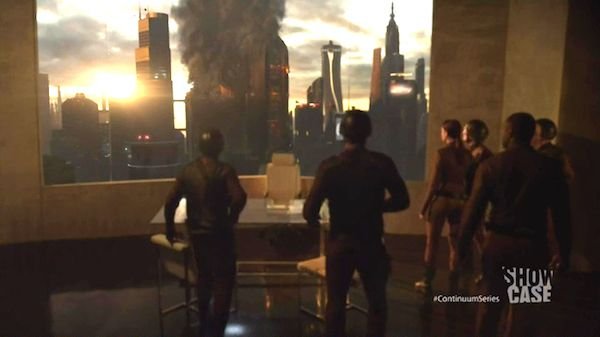
Similarly, the monologue through which the contours of this fictional world are first revealed, delivered with gravitas and apparent sincerity rather than the oily cynicism of an opportunist, establishes a recognizable conflict, invoking the dystopian hero’s rhetoric of liberty reasserting itself against an authoritarian power (here, corporate in nature). At the same time, the earnest horror in the eyes of the representatives of law and order as they watch the tower fall suggests the profound gravity of revolutionary violence. The destructive act emerges out of and against what seems like firmly dystopian circumstances—begging for radical resistance precisely because they seem to foreclose the barest possibility of any other kind—but this destruction plays, even in this initial scene, as anything but an unalloyed, liberatory triumph.
• • •
Following the destruction of the Corporate Congress building, the other members of Liber8 are rounded up and, along with Kagame, sentenced to public execution. Before they can be put to death, Kagame triggers a smuggled-in time travel device that sends the eight Liber8 condemned—along with accidental co-time-traveler Kiera Cameron, the CPS officer who has already been narratively and visually positioned as the relatable protagonist—from the execution chamber back in time to 2012. The plan, familiar from myriad other time travel tales, is a last ditch effort to avert the inevitable by hacking the timeline: as Kiera puts it in explanatory voiceover atop the opening credits of each episode, Liber8 travel back “to corrupt and control the present, in order to win the future.” It is soon revealed that the plan was to travel back six years, to 2070, but somehow they were all sent back over six decades instead, as though the fictional world were dropping metaphysical hints for its characters that the roots of corporate hegemony run far deeper.
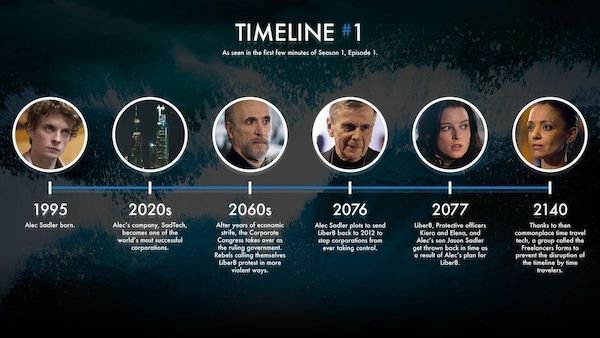
Absent the political context established by Kagame’s initial monologue and borne out more fully as the series goes on, the resulting setup would have made for relatively unremarkable popcorn fare: dutiful cop chases time-traveling terrorists into the past, trying to prevent them from altering history. In light of Kagame’s polemic and Liber8’s broader anti-corporate project, though, the stakes of maintaining the timeline—often, in other works, purely dramatic—become starkly political: to maintain the timeline is unavoidably to ensure a future of oppressive corporate hegemony. David Wittenberg has noted the reliance of time travel narratives on “conserving maneuvers, designed either to restore the past or to protect it from potentially illogical interference” (151). In Continuum’s case, these conservative maneuvers militate against not only the incipient “narratological radicalism” that Wittenberg suggests inheres in the time travel trope but also the political radicalism that opposes corporate hegemony (151). In other words, the inertia against which Liber8’s temporal Hail Mary crashes is simultaneously ontological (altering history threatens all of existence) and political (altering this history threatens the Corporate Congress); the conservative tendency of time travel, by which “time travel fiction pushes back against its own drive to become more radical, subversive, or chaotic” (Wittenberg 151), conflates the ontological and the political narratively, thereby naturalizing a de facto anti-radicalism (stopping Liber8) as a metaphysical necessity (maintaining the timeline). The plot structure Continuum sets out for itself thus seems to narratively buttress corporate inevitability, making the policing of radical anti-corporate resistance an ontological, world-saving imperative. The second season of the show even introduces a nominally neutral group, positioned above the in-world political fray, whose self-appointed charge is to preserve the established timeline (within which 2076 yields corporate hegemony). But again, in the political context the show establishes and rigorously maintains, this seemingly apolitical charge has the most profound of political consequences: to keep reality from breaking is to stymie Liber8’s last-ditch effort to resist corporate hegemony.
Within this framework, though—that is, within the narrative structure I have argued is integral to the corporation’s self-narration as inevitable—the show moves in surprising ways to resist this kind of structural conservatism. Of particular relevance is the way its dramatic and political arcs move at odds with one another. As Kiera pursues Liber8 through 2012 Vancouver, frantically thwarting their various attempts to rewrite the prehistory of their corporate dystopia, most of the standard narrative and ideological markers of the heroic protagonist accrue to her. Where Liber8 is disjointed, plagued by infighting and tactical disagreement, Kiera is single-minded, determined. Where Liber8 seem to have no attachments to their time or regrets about leaving it behind, Kiera constantly flashes back to her husband and son, to whom she desperately hopes to return. Where Liber8 is violent, even gleefully brutal at times (its brutality often captured in unforgiving long takes that linger on the deliberateness of the violent act), Kiera claims a law-and-order flavor of pacifism, wherein violence is only ever reluctantly and temporarily sanctioned as a way of preventing further violence.
These characterological archetypes seem to promise a straightforward struggle between the heroic—duty-bound, competent, efficient, faithful to family and institutions, intent on maintaining the timeline and thus the hegemony embedded within it—and the villainous or anarchic. But the arc of the series and the narrative structure of the episodes flesh out the context of Liber8’s politics—and, implicitly, of the law and order ethos Kiera imagines to be apolitical and nonviolent but which comes to seem more clearly malignant with each subsequent glimpse of the corporate-dystopian future. Flashbacks to the pre-execution-chamber future reveal, for instance, that one Liber8 member was a soldier, biotechnologically enhanced and then coldly discarded by corporate military researchers before being freed by another Liber8 member, a physician and medical researcher having ethical qualms about weaponizing human beings without their full knowledge or consent. Details like these humanize a set of characters who might otherwise have seemed transparently villainous, but perhaps more importantly, they substantiate Liber8’s politics—its diagnosis of the ways corporate hegemony propagates violence and oppression, if not necessarily the actions it pursues in response. Episodes typically follow an ostensibly primary plot in 2012 interspersed with a secondary plot in the dystopian future, the latter providing both urgency and context to the former. In aggregate, these contextualizing flashes work to divorce political and characterological affiliations: though Kiera remains the show’s narrative and affective center, her fealty to and attempted maintenance of the corporate-hegemonic 2076 world in the face of time-traveling radicalism is gradually revealed to be at best misguided, at worst grotesquely reactionary.
The way the show untethers character and political identification casts the question of resisting the corporate dystopian scenario in a substantially different light. Where popular dystopian fictions from The Matrix to Divergent tend to subordinate critique or political substance to a generic characterological framework (oppressive collective villain vs. heroic individualist resistance) built of calcified Cold War fears, this untethering pushes questions of anti-corporate politics to the forefront. Continuum refuses to dismiss the political arguments of its supposed antagonists, and indeed offers considerable narrative support to the anti-corporate critiques of both real and fictional worlds, over and against the vicissitudes of audience sympathies. It also refuses to let its anxiety about the brutality Liber8 sometimes employs (itself a frequent object of both strategic and philosophical disagreement among the Liber8 ranks) function as a rebuttal to or a distraction from the substance of Liber8’s anti-corporate critique. Rather than marshaling politics as merely another subordinate identifier of characters one ought to root for or against, the show’s crossed narrative and political streams shift the focus to the essential question of anti-hegemonic politics: how does one resist that which has made itself inevitable? For Continuum, anti-corporate politics becomes less about the tactics of individualist resistance against corporate-authoritarian villains and more about fracturing the totalizing narrative ecosystem of corporate inevitability, within which all possible stories seem to lead to the same endpoint.
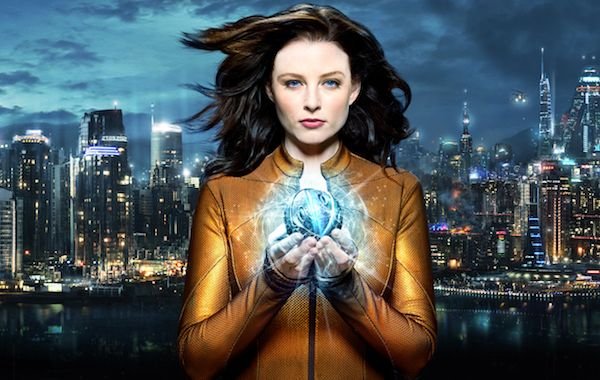
Beyond dramatizing Kiera’s complicity in the structures of corporate hegemony that make the show’s 2076 world so dystopian, the narrative form of Continuum’s episodes—suturing the straightforwardly procedural concerns of the 2012 stories to the ethical and political complications of the 2076 stories—models Kiera’s own coming to consciousness about that complicity. The edits between 2076 and 2012 scenes often visually and thematically frame the future scenes as memories conjured for Kiera by present-day events, memories that serve to cast a critical light on things she might otherwise have ignored. Initially, the stakes of this future-remembering are narrowly dramatic, as Kiera’s memories provide insights that help her thwart criminal machinations in 2012 (as when, for instance, she is able to catch a serial killer whose case she remembers having studied decades later). As the series progresses and Kiera grows more ambivalent about her role, these futural flashbacks take on an increasingly political valence, instead illuminating (for both Kiera and audiences) the trajectories of power and violence connecting 2012 and 2076. Where the conservative tendencies Wittenberg identifies in time travel stories might have further naturalized the corporate future even while recognizing it as dystopian, thereby shoring up the ideologies of inevitability, Continuum’s particular narrative form harnesses science fiction’s power to defamiliarize and thereby historicize. Kiera’s ideological journey is a sort of chronological reverse of science fiction’s usual arc of cognitive estrangement, wherein an experience with some radically other but plausibly extrapolated future estranges the present that until that moment had seemed natural and unremarkable. For Kiera, the estranging moment is precisely the prehistory of what seems to her proper and inevitable: a world of government by for-profit corporations whose interest in their citizens is fundamentally as investments and commodities.
• • •
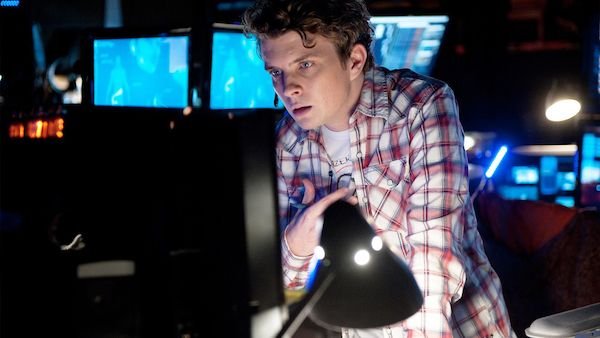
The double-helix companion to Kiera’s narrative arc is that of Alec Sadler. Just as the show’s flashback/flashforward structure offers two Kieras, the space between them providing the terrain for its ethical and political questions, Alec too exists in duplicate. In 2012, he is a prodigious and reclusive teenage hacker on whose assistance Kiera comes to depend greatly; in 2076, he is a leader in the Corporate Congress and the founder and head of SadTech, engineers of most of the technology used by law enforcement and one of the more powerful companies in the corporatocratic landscape. If Kiera’s trajectory over the course of the series is the gradual comprehension and rejection of her role in systems of corporate authority and oppression, Alec’s implied arc across six decades involves somehow bridging the gap between a kind, loyal, introverted teenager and a cynical, manipulative member of the corporate elite.
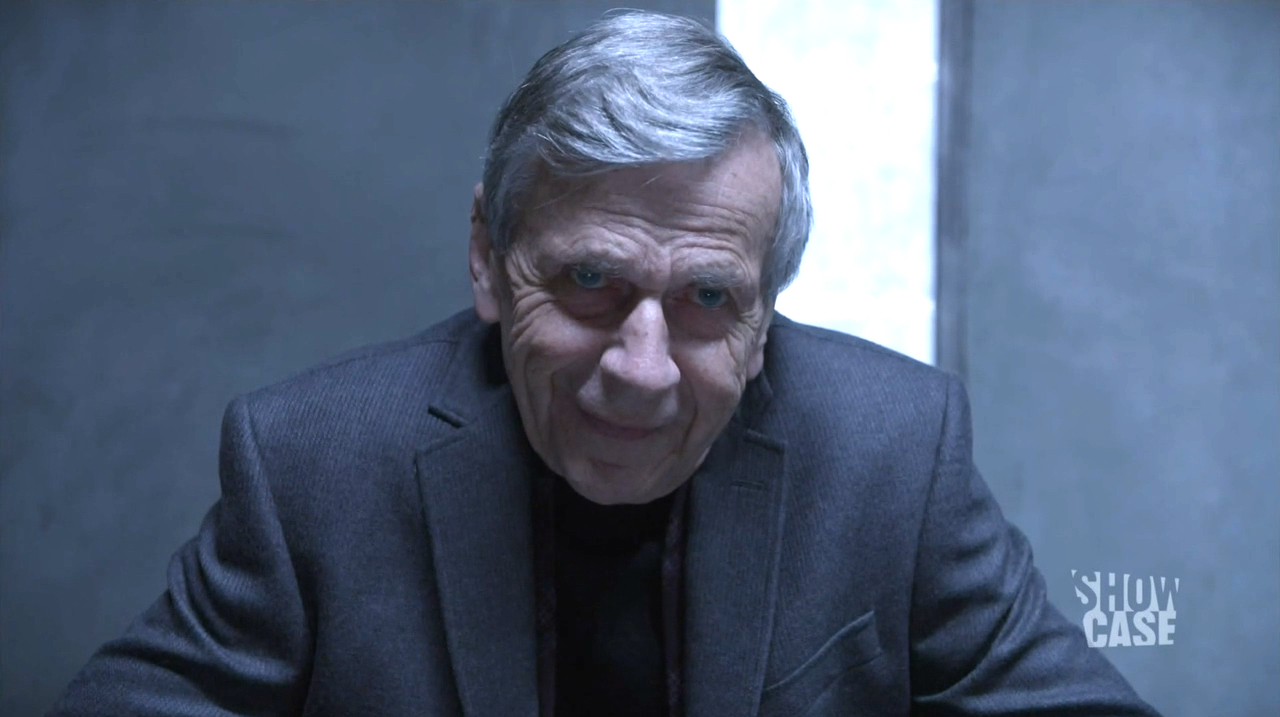
The question of how teenage hacker Alec becomes SadTech/Corporate Congress Alec and whether there might be a way to short-circuit such a transformation is the question of inevitability at the micro scale. He is the figure of the fictional world’s becoming-corporate; if Continuum is in part a bildungsroman of corporateness, Alec is its unsuspecting narrator. Though the seeds of a de facto pro-corporation politics are present from the get-go—Alec’s stepfather and stepbrother are anti-corporate and anti-technology activists, but Alec remains fiercely skeptical of their claims—the possibility that he will grow up to be one of the most powerful figures in a dystopian corporatocracy engenders the show’s central anxiety. The fear of inevitability is in this case the fear that the posthuman, transtemporal corporate form—“an entity whose head can suddenly emerge at any point, since as an artificial person it must borrow the hands, eyes, legs, and mouths of its natural representatives, who begin to move on its behalf and speak in its name” (Turner 125)—will speak through us, even through the most innocent or unwilling of us, without our consent. To say that the corporation is inevitable is, in some sense, to say that the corporation is the only character exerting true narrative control, that it has already shaped futurity itself—the possibilities of novelty and radical otherness, the possibility of change—to its advantage, independent of the schemes and interventions of human characters.
The show’s narrative takes as its playing field precisely this corporate futurity: a future founded on a present ostensibly not yet decided, but on which entire world-historical infrastructures are built. Elana Gomel argues that time travel ought to be regarded “as an inscription of a particular ideology of temporality” (334), a “philosophy of determinism, which implies that there is only one ’true’ narrative of history, and thus the seeming open-endedness of the future is an illusion” (335). Continuum explores the ways this ideology of temporality is woven tightly into the corporate interface. The corporation’s present, here as elsewhere, is the opening between the past to which it imagines itself a solution and the future in whose inevitability it traffics, precisely by attempting to foreclose other possible, potentially radically different futures, even while capitalizing on their rhetorical appeal to sell visions of a better world. In this way, time travel is the narrative structure most proper to the show’s corporate-hegemonic world, and the ground out of which any potential resistance must on some level emerge.
Time travel, in other words, seems in Continuum’s world like the last potential way around the dystopian inevitability installed by corporate hegemony and the failure of political imagination augured by that inevitability narrative, though even that fantasy of hacked-timeline resistance marks the deep saturation achieved by the corporation, so profound as to necessitate the bending of ontology to near its breaking point. (What better signal of hegemony than the marking of resistance as necessarily science-fictional?) Eventually it becomes depressingly clear that even these seemingly radical eventualities have already been leveraged by the corporatocracy. Toward the end of the show’s first season, it is revealed that 2076 Alec Sadler, head of SadTech, was the one who enabled the Liber8 members—and Kiera—to travel back in time in the first place, for purposes as yet unrevealed (at the time of this writing, the series has not yet concluded). Even as the show marshals the narrative machinery of time travel to rethink the gaps between our “corporate” and “anti-corporate” selves, that machinery proves in-world to be inextricably bound to corporate hegemony, steered by the corporation’s most privileged agent.
Crucially, time travel as Liber8’s activist strategy in the fictional world—perhaps echoed in non-science-fictional reality by something like rearguard actions to overturn this Supreme Court decision or retroactively bring that corporate villainy back within the realm of regulatory capture, to rewrite the history of corporate personhood or corporate overreach—yields dubious results. To the extent that time travel bears fruit for either Liber8 or Continuum, it succeeds in the slow, unglamorous work of dismantling the narratives of inevitability that buttress corporate futurity. This is science fiction as a denaturalization machine, close cousin to critical theory, the demystifier that reveals (to audiences as to Kiera herself) the structures that underlie the fiction of corporate dystopia’s inevitability by showing its historical contingency and reopening the radical possibility of imagining a different kind of world. Futurity has often been the vector for such radical imaginings, but as futurity is made to seem irreducibly corporate, inevitably colonized in advance by hegemonic structures (perhaps no less so in the real-world present than in Continuum’s future), one seeks other soils in which to replant the seeds of radical imaginaries.
When time travel is always already part of the corporation’s narrative interface, part of how the corporation narrates its own transhistorical presence and mortgages some futures as a way of ensuring others, it no longer functions intrinsically as a mode of resistance, historicizing, or imaginative liberation in and of itself. But recognizing and interrogating time travel as part of the corporate interface, rather than as something counter-hegemonic by its very essence, might offer a new ground from which to think beyond and against corporate inevitability. An anti-corporate narrative form able to repurpose the narrative logic of time travel for counter-hegemonic purposes—to think outside the structures around and within which the corporation operates—might reinvigorate the possibility of thinking outside the bind that confronts any resistance to inevitability: the non-choice between this is all there is or ever will be, and we’d better make the best of it and blow it all up. Continuum offers one model of what such a form might look like, and of how it might reinvigorate radical imaginaries in an era that dares not hope for much beyond reparative incrementalism. For those seeking to resist corporate domination of the collective imaginary, the task remains to think outside these ideologies of inevitability, corporate in their total capitalizing of speculation, futures built atop futures, narrated implacably into algorithmic, fractal permanence.
Works Cited
“A Stitch in Time.” Continuum. Prod. Simon Barry et al. Showcase. 27 May 2012. Television.
Blackstone, William. Commentaries on the Laws of England. Vol. 1. Oxford: Clarendon P, 1765. Google Books. Web. 3 Dec. 2015.
Gibson, William. Pattern Recognition. New York: G.P. Putnam’s Sons, 2003. Print.
Gomel, Elana. “Shapes of the Past and Future: Darwin and the Narratology of Time Travel.” Narrative 17.3 (October 2009): 334-352. Project Muse. Web. 12 June. 2015.
Jameson, Fredric. “Future City.” New Left Review 21 (2003): 65-79. Web. 10 Nov. 2015.
Suvin, Darko. Metamorphoses of Science Fiction: On the Poetics and History of a Literary Genre. New Haven: Yale UP, 1979. PDF file. 10 Nov. 2015.
Turner, Henry. “Toward an Analysis of the Corporate Ego: The Case of Richard Hakluyt.” differences 20.2-3 (2009): 103-147. Web. 10 Nov. 2015.
Wittenberg, David. Time Travel: The Popular Philosophy of Narrative. New York: Fordham UP, 2013. Project Muse. Web. 12 Jun. 2015.
Figures:
Fig. 1: Simone, Gail (w), Oscar Gonzalez Loyo (p), Steve Steere, Jr. (i). “…So You Want to Work for Globex, Huh?” Simpsons Comics 66 (Jan. 2002), Bongo Comics Group. JPEG.
Fig. 2: “Clip from opening scene of ‘A Stitch in Time.’” Continuum Season 1, Episode 1. Showcase. 27 May 2012. Television.
Fig. 3: “Screenshot of Corporate Congress headquarters exploding from ‘A Stitch in Time.’” Continuum Season 1, Episode 1. Showcase. 27 May 2012. Author’s Screenshot.
Fig. 4: “Promotional image of one of Continuum’s timelines.” “Continuum’s Timelines.” Syfy.com. Syfy, n.d. Web. 10 Nov. 2015. JPEG.
Fig. 5: “Promotional image of Kiera Cameron and the two Vancouvers.” ”TV this Week: Continuum’s finale, Under the Dome secrets revealed and more!” Blastr. Syfy, 26 Aug. 2013. Web. 10 Nov. 2015. JPEG.
Fig. 6: “Promotional image of 2012 Alec Sadler.” “Season One 101.” Syfy.com. Syfy, n.d. Web. 10 Nov. 2015. JPEG.
Fig. 7: “Screenshot of 2076 Alec Sadler from ‘End Times.’” Continuum Season 1, Episode 10. Showcase. 5 Aug. 2012. Author’s Screenshot.

